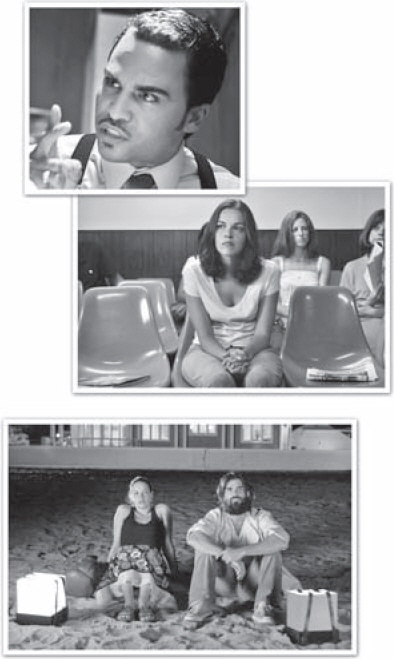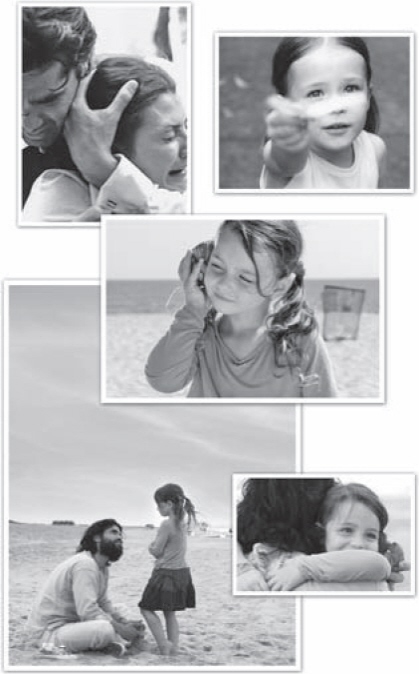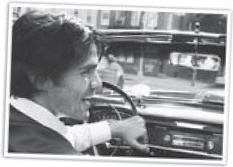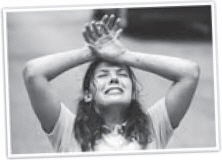Bella (17 page)

“This was the last gift my father gave to me,” Nina said.
“Thank you.”
Bella hugged the bear and ran her chin along its head. She handed Nina the shell in return.
“Thank you,” Nina said.
“You're welcome. When you're away from the ocean, you can hear the waves. Anytime you want.”
Nina looked up at José, and another sob tumbled from her mouth. She stood up and he put his arms around her. “Thank you so much,” she cried, her tears soaking into his shirt. “I'm sorry . . .”
“Shh,” he said. “We all love you, Nina.” And he looked down at Bella, hugging the little bear. Who could have known?
“Bella . . . ,” Nina said.
Bella held out her hand. Nina took it.
José scooted around the other side and took Bella's other hand. “Would you like to walk with us?” he asked.
“Yes, I would like that.”
They headed toward the surf, waves rolling and crashing, whispering of life, providing a song for the day's dance.


I
didn't have a big budget, but I had New York City,” Monteverde says emphatically. “You can shoot there with 50 million dollars or 1 million dollars and it's still New York Cityâthe biggest celebrity you can find. I needed that city no matter what.”
“And he got it,” says producer Denise Pinckley, whose feature film credits as production manager include
The Manchurian Candidate,
The Legend of Bagger Vance,
and
Analyze This.
Pinckley was recommended to Metanoia as a smart producer and a troubleshooter who could make their money go a very long way. At the time, she was considering a job on a big-budget film as a production manager that would also shoot in Manhattan. But her meeting with the charismatic Monteverde made the same dramatic impression that it had made on others. She declined the big Hollywood film and set out to do her best with an indie budget.
“Professionally, it was a choice between something I knew I could do and something I believed I could do, and
Bella
was where my heart was,” says Pinckley. “Alejandro was so committed to
Bella
that once we discussed it, I never wavered in the belief that we could shoot in New York, the way he wanted it, and with the resources we had available.”
As the move started to come together, Monteverde also tapped Andrew Cadalago, his good friend from the University of Texas film school, to work as his cinematographer. The two had partnered on student films and had developed a comfortable shorthand for getting the job done artistically and economically.
The next challenge was casting.

“Suddenly, it was three weeks before shooting and we were still seeing actresses,” says Verastegui. “I had been wearing the producer's hat for so long, in lots of meetings, that I had forgotten to concentrate on my role as José. Acting is like a muscle and it has to be exercised, so I began to focus on the character.”
“In a way, Eduardo is like his character José in real life,” explains Monteverde. “I had seen the way he connects with people, and I wanted to capture that. Eduardo is also very handsome but I didn't want the audience to be distracted by that so we came up with the idea of a full beard and long hair. I told him that I didn't want to see anything but his eyes.”
“For me, I was eager to erase the last twelve years of my career, the stereotype of the Latin lover,” says Verastegi. “José is impulsive on the say of our story, but the thing I like best about him is that he listens. And he is very close to his mother and his family, like I am.”
“I know how much Eduardo can communicate with his eyes, and I know that he is a passionate manâbut I was very tough on him,” admits the director. “Not because he was doing badly, but because I wanted to break him down. I was tougher on him than anyone else on the set. I wanted to break him and capture that vulnerable quality on film.”
Looking back on the experience of being directed by his demanding friend, Verastegi says, “Alejandro takes you deep and lets you go, giving the actor the freedom to create. He's my brother.”
In the role of Nina, whose wounded spirit touches something deep in José, Monteverde cast actress Tammy Blanchard, who had also recently been hired for Robert DeNiro's big budget feature film production
The Good Shepherd
, opposite Matt Damon. An Emmy-award winner for her star-turning role in ABC's television epic
Me and My Shadows: Life with Judy Garland.
Blanchard was the first actress to read for the role of Nina. Subsequently, she asked her managers to set up a second meeting with the first-time director.
“She said quite directly, âI want you to know that character is mine.' She was very determined but also very humble. I called her that night and told her that I had faith in her. She had the role.”
Blanchard explains, “I don't do a project unless I feel I can put my heart and soul in it. I responded to the brokenness of these people . . . the city of Manhattan is full of people who are lost and confused and everyone is looking for that saving grace to pull them out of their pain. I thought this was a true, honest story.”
“Tammy and I would walk around the set talking about the character,” Monteverde continues. “And even though she has quite a few emotional scenes, she's a one-taker. If we went further, it's because I had other technical things in mind, but she always got it the first time.”
“As soon as we started rehearsing, I could see how talented, and how transparent she was,” says Verstegui. “She was full of positive reinforcement and I wanted to protect her with mutual support.”
“Nina is a lost lamb and somehow a shepherd comes along,” explains Blanchard about her character. “She follows José to a safe place where she can express herself, and when he opens up about his life, he practically breathes life into her.”

A third character, a mother who meets José under difficult circumstances at the height of his soccer career, is played by Ali Landry, who was then the girlfriend (and now, wife) of Monteverde. Although she's a talented actress who is known for her co-starring role on the TV show
Eve
, the director insisted that she get no special consideration.
Instead, she took the time to prepare her own audition tape.
“And she knocked us out,” says Serervino. “She had such emotional depth that we had no hesitation about casting her as Celia.”
Packed into the
tight twenty-four-day shooting schedule were numerous scenes in Manhattan, including the Mexican restaurant scenes which took place at Il Campanello on West 31st Street; José's family home, written as Long Island, was shot in Rockaway Beach, Bella Harbor, Queens; and the movie's early scenes which establish José as a soccer star were filmed in Greenpoint, Brooklyn.
Shooting at least six pages a day, which is twice that of a normal feature film pace, Monteverde encouraged his department heads to move briskly but creatively. Production designer Richard Lassalle not only helped establish the characters and environments with his artistic input and original ideas, but he gave every set his personal attention, including the colorful mural he painted in the restaurant.
“Looking back, I can say that this production was blessed,” observes Pinckley. “I tried to anticipate the many obstacles that can get in your way, from weather problems to shooting in the crowded streets, but everything went incredibly smoothly.”
With just two days of exteriors left to shoot, Monteverde did eventually come to a bump in the road. Not a drop of rain had fallen the previous weeks of shooting, but a storm hit the night before and it seemed certain that it would jeopardize two important exterior scenes in Brooklyn. “On Thursday, Denise had to break it to me that there was a 99 percent chance that it was going to rain the next day,” recalls the director. “But the weather had been on our side for the whole shoot. So I said, let's come out tomorrow and shoot. But everyone thought I was crazy. So I woke up the next day and it was raining like mad. I drove to the set at 6:30 a.m., and here's our gaffer pointing to his computer and all the evidence that it would rain us out.”
“We all stood on a corner with the rain dripping from trees, but the backyard where we wanted to shoot was relatively dry,” recalls Pinckley. “So I ordered the crane that Alejandro had his heart set on.”
“I was stubborn,” admits Monteverde. “I looked up and I saw a hole in the skyâmaybe the size of one airplaneâand I'm thinking that this hole is going to stop over head and we're going to be able to shoot. Eduardo and Denise believed me. So we took a big leap of faith and set up. At 9:00 a.m. the rain stopped just two blocks away. If you had moved one block further in any direction, it would be raining. And according to the computers, it was even raining in our neighborhood. But we were dry until we finished shooting at 7:00 p.m., and then it started raining. It was a miracle. I would definitely call it a miracle.”
At the end
of the shoot, Monteverde returned to Los Angeles, where he teamed with editor Fernando Villena to find the visual, emotional story that the filmmakers wanted to tell. To compose the film's original score, Metanoia hired first-timer Stephen Altman, who not only wrote the music but personally performed each instrument himself before building a score that evokes hot salsa rhythms as well as quiet themes and intimate musical portraits.
José, played by Eduardo Verástegui
Born and raised in Xicotencatl, Tamaulipas, a tiny village in Northern Mexico, Verástegui was the son of a sugar cane farmer. At the age of 18, he left his small town and headed to Mexico City to pursue a career in entertainment. Twelve years later, Eduardo had toured the world as a singer in the Mexican pop sensation Kairo and as an acclaimed solo recording artist, performing sold-out concerts in over thirteen countries.
Starring in five highly-rated Spanish soap operas for Televisa (broadcast in over nineteen countries), he has also been featured on hundreds of international magazine covers, including
People En Espa-ñol
, which voted him one of the 50 Most Beautiful People. Verástegui has appeared opposite Jennifer Lopez in one of her most famous music videos “Ain't it Funny!” as well as in an international television commercial promoting her self-titled commercial fragrances.